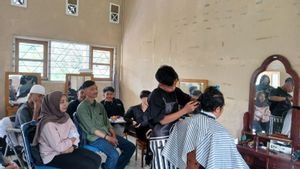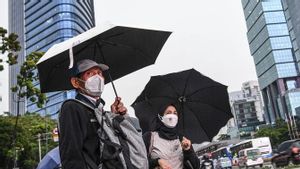JAKARTA - Water-carrying plants are semi-dwarf plants. These plants can be found worldwide, especially in the highlands in the tropics and subtropics. The main centers for the diversity of water-carrying genus are found in Africa, Madagascar, India, Sri lanka, Himalayan, and Southeast Asia. In the world, there are about 1,300 species of girlfriends and about 250 species, among others, are in Southeast Asia. Meanwhile, in Indonesia water-carrying plants can be found throughout the island, especially in the highlands. In addition to being ornamental plants, water girlfriends can also be used as traditional medicines. Water-carry flowers contain flavonoid compounds, antosianin (cyanidin-3-glycoside), kaempherol, and phenolic compounds in all parts of the plant. Benefits of the content of these compounds are used to reduce swelling and skin inflammation, treating fractures, boils, whiteness, high blood pressure, menstruation, mechanical, back pain, and yellow pain.
The National Research and Innovation Agency (BRIN) is carrying out activities to utilize water-carrying plants to produce superior varieties as ornamental plants and traditional medicinal raw materials. Researcher BRIN Horticulture Research Center Suskan from Kartikaningrum said it was trying to create a water lover that is adaptive to low-lying and high-temperature tolerant. "We chose a water girlfriend because it has the desired character, which can improve the character of the High-temperature Impatiens hawkeri," he said, quoted from Antara, Saturday, June 15. In 2022, BRIN began performing breeding activities to search for high-temperaturely tolerant types of imppatients (Playpetala Impathenes) by exploring to Toraja, South Sulawesi (Sulsel), and around the corridor of Mount Halimun-Salak, West Java. Researchers found one water girlfriend from South Sulawesi and six water girlfriends taken from the corridor of Mount Halimun Salak. After further tests were carried out, which from West Java only had two accessions that had a high-temperature tolerant character.
SEE ALSO:
The two selected accessions are used as male elders to repair varieties that are already circulating in the community which are currently apparently intolerant of high temperatures and are not adaptive in the lowlands. The assembly activities of the new varieties began in 2023 and have now produced around 2,000 clones. Of the 2,000 clones, 24 clones have been indirectly selected for high-temperature tolerant characters. "A total of the candidates will be netted in collaboration with the private sector to choose the plants preferred by the community. Currently, a second re-evaluation and planting are being carried out in the Bogor area," said Suskandari. He revealed that currently there are two clones that have been registered as ownerships, namely varieties with the names Alifa and Bella. Then there are about eight clones that will follow to be registered and will be released as new varieties. "Some more will be registered to the Ministry of Agriculture for the protection of plant varieties," said Suskandari.
The English, Chinese, Japanese, Arabic, and French versions are automatically generated by the AI. So there may still be inaccuracies in translating, please always see Indonesian as our main language. (system supported by DigitalSiber.id)

















